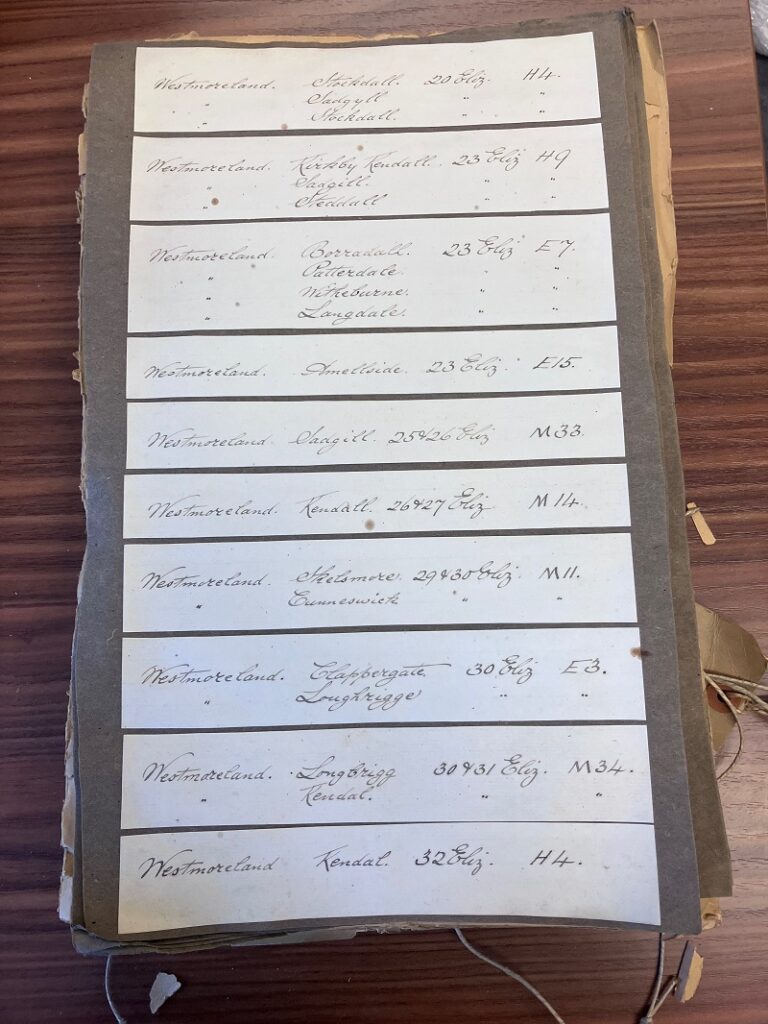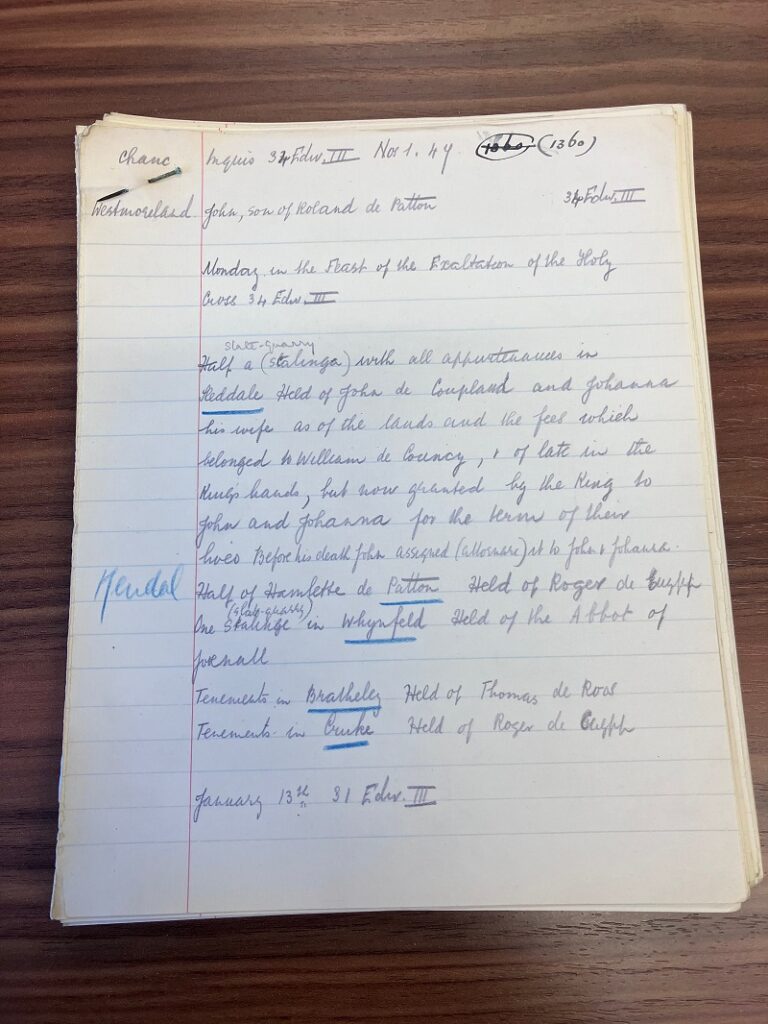In this blog post Adam Chapman (VCH General Editor) and Ruth Slatter (VCH Architectural Editor) explore the VCH Westmorland archive and reflect on how it helps uncover the hidden (and often forgotten) labour of researchers who contributed to the production of early VCH volumes.
Today the The Victoria County History (VCH) is one of the world’s longest-running research projects. However, when initially founded in 1899 the aim was to write an authoritative and encyclopaedic history of every county in England in 6–7 years. The plan was for each county to have a general introductory volume, including information about its natural history, archaeology, ancient history, and Domesday Book entry. This would then be accompanied by a second volume covering the county’s medieval religious houses and general topics such as political history, social and economic history, agriculture, sports history, and schools. Finally, it was intended that each county’s history would be completed by a series of ‘topographical’ volumes providing detailed histories of each parish.
By 1908 the VCH project faced financial uncertainties and some volumes that had been planned and researched were never published. This included the introductory volumes to Westmorland. The material gathered during the preparation for these unpublished volumes was packaged up—in the state it was in when pens were downed—and archived. This material is now either deposited in county archives or the central VCH archive.

We, the central VCH editorial team, have recently spent some time exploring the Westmorland VCH archive as part of the process of putting the finishing touches to the first Westmorland VCH volume, which has been researched and written by our colleagues in the Cumbria County History Trust. In the archive we found a range of different materials, including maps of the Cumberland and Westmorland, handmade finding aids to help VCH researchers and writers discover relevant archives in the Public Record Office, and ‘slips’ made by VCH researchers to record the location and sometimes content of relevant references in the Public Record Office.



We also unearthed detailed research notes, transcriptions of data sets, and illustrations—mostly tracings of earthwork diagrams—that appear to have been prepared for inclusion in the unpublished volumes.



Finally, we also discovered several letters from contractors who conducted research for the VCH and members of the public who sent the VCH information they thought would be of value to the local history project.

These archives are of particular interest because they help to uncover the considerable, yet hidden and often forgotten, labour of researchers who never became named authors in the early VCH volumes.
For instance, one of the items in the archive is a series of letters from Arthur F(rederick) Heintz, a record agent. In the late nineteenth and early twentieth centuries, professional historians, especially those working in universities, employed record agents to do their archival research. It was therefore record agents, paid by the line for their transcriptions and notetaking, who laid the foundations for many of the early works of professional history. You can occasionally find record agents named without further details in acknowledgements or complimented on the precision of their transcriptions in introductions. However, their contributions to historical research are largely hidden and forgotten. Arthur F. Heintz’s letters in the VCH Westmorland archive provide wonderful insights into the work of record agents. In them, he explains the research he was undertaking, outlines how he recorded and ordered the information he found, and makes references to the invoices he has sent for his work. These letters also provide an important reminder of how Heintz—and the many other professional record agents who were contracted by the VCH—provided essential, yet unacknowledged, contributions to the early volumes of the VCH.

There is also a letter in the Westmorland archive from Mr Briggs Caton (or perhaps Calton depending on how you read his handwriting!). Mr Briggs Caton was a gardener at Woodlands, Haworth, but had been born in Kendal. In his letter, he explains how he had read about the VCH Westmorland project in a Kendal newspaper (which he still had delivered to him in Yorkshire) and thought the VCH would find his (apparently amateur) research into the pedigree of the local Briggs family useful for their publication. This is a fascinating indication of the role that members of public made to the VCH in the early twentieth century.

Finally, the majority of the VCH Westmorland archive comprises of ‘slips’—half sheets of foolscap paper containing research notes on individual places—and finding aids that were made by VCH researchers in the Public Records Office in the early twentieth century. These researchers were employed to read through the various series of Ancient Deeds, State Papers, Feet of Fines, published Calendars, etc. and record the location of relevant references to counties, hundreds, and parishes.
Documents in other parts of the VCH archive reveal that many of these researchers were women. This willingness to employ female historians was a hallmark of the early years of the project. For instance, in 1904 S.R. Scargill-Bird wrote to William Page, the VCH General Editor, complaining that ‘the presence of as many ladies employed on the Victoria County History in the Legal Search Room [of the Public Record Office], is I am sorry to say causing great inconvenience to the General Public.’

Recent work by our colleague Amara Thornton on the Beyond Notability project, has brought to life the words and thoughts of Eliza Jeffries Davis and Margerie Venables Taylor, two of the women who produced published work for the VCH in the early twentieth century. However, the names of many of the women the VCH employed to conduct research have subsequently been lost and it is almost impossible to ascertain which researcher looked through which document and produced the specific slips that contributed to published and unpublished VCH volumes.
Nevertheless, as Liz Haines (2019) has demonstrated in her exploration of colonial archives in Zambia, the material culture of archived documents can be used to uncover the hidden and forgotten labour of people whose names and jobs were either unrecorded or have subsequently been lost from the record. For instance, looking at the documents in the VCH Westmorland archive, we can use handwriting patterns to group slips and identify bodies of work that were undertaken by the same person.

Various forms of paper fastenings are also evocative of these researchers’ working practices and indicate a methodical process of recording and filing information.

Handmade finding aids included in the archive, with their wonky edges that were clearly hand cut with a pair of scissors, embody the physicality of the work these researchers were undertaking. While the handwritten index book for slips relating to Westmorland, suggests they required an eagle eye for detail, and precision in recording it.


Ultimately, these researchers had to simultaneously ensure they found all the relevant references in original archival documents—that were often difficult physically open let alone read—and record this information in a way that could be easily used by the (mainly) male academics and authors who were credited in the early VCH volumes.
Our foray into the Westmorland VCH archives has revealed the hidden labour of uncredited researchers, contractors, and members of the public and therefore suggested that the early VCH volumes would never have been possible without them.
The first Westmorland VCH Big Red Book will be published in the near future. Many of the VCH volumes are freely available via British History Online and more will be added during 2024 and 2025. To keep up to date with VCH news follow us on Twitter (X) @VCH_London and Bluesky @vchlondon.bsky.social.

